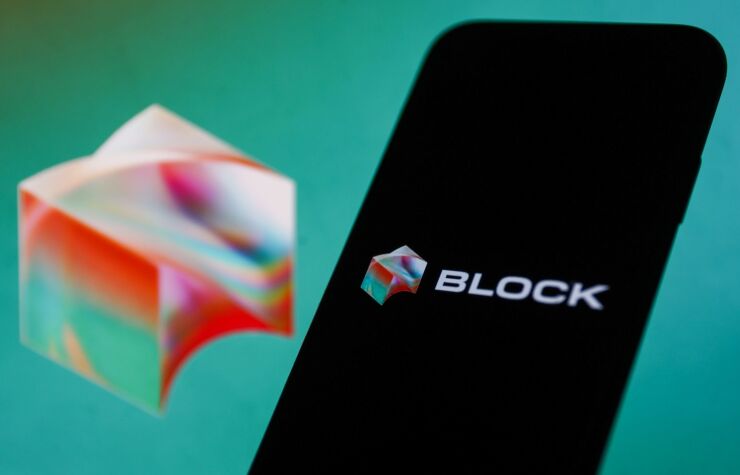
Block is unifying its Afterpay, Cash App and Square units as part of a broader expansion strategy that it projects will show up in earnings by early 2026.
"In 2024 we built the foundation for our next era of growth, and we're excited about our momentum heading into 2025," Block's Chief Operating Officer and Chief Financial Officer Amrita Ahuja said during the company's fourth-quarter earnings call with investors on Feb. 20.
Results for the fourth quarter ended Dec. 31 were mixed, hitting a sour note with investors. Revenue came in at $6.03 billion, an increase of 4.5% year over year but below analysts estimates of $6.26 billion, according to S&P Capital IQ. GAAP net income, meanwhile, landed at $1.95 billion, or $3.05 per share, above analysts' consensus of $252.38 million, or 41 cents per share. Adjusted EPS hit 71 cents per share, under analysts' expected 87 cents per share.
Guidance for 2025 remained in line with management's
Expansion of banking services on Cash App were a key driver of success for the year, JMP Securities said in a research note. Cash App paycheck deposit activities hit 2.5 million as of December 2024, an increase of 25%, and the Cash App Card had 25 million active users, a 9% increase.
Block estimated that 21% of 18-to-21-year-olds in the U.S. used Cash App Card in 2024.
Looking closer, Cash App gross profit hit $5.24 billion, an increase of 21%, and gross profit per monthly active grew 13%. Square gross profit tallied $3.6 billion, an increase of 15% with gross payment volume landing at $58.9 billion, up 10%. Square launched several new products this year designed for food and beverage sellers, including scan-to-pay functionality, and rolled out a single app. It also increased its marketing spend in Q4 60% to help drive higher customer acquisition.
Investors weren't impressed. Block's stock was trading down nearly 7% in after hours trading on Thursday evening and was down 11% to $74.01 per share when markets opened in New York Friday morning.
Growth in Square's gross payment volume, increased interest in Cash App Borrow and its paycheck deposit functionality, and the addition of Afterpay's buy now/pay later to the Cash App Card – which launched this week – are expected to continue to be key drivers of growth this year.
"Encouragingly, important first steps are already being made here like the launch of Afterpay on Cash App Card this month - a product we're eager to track progress around," JPMorgan Chase said in a research note.
The payments company turned commerce platform last year
"Our strategy is to bring our ecosystems together with a focus on neighborhoods," CEO Jack Dorsey wrote in the letter to shareholders. "Block by block, we will build a new 'neighborhood network' that connects sellers, buyers, staff, and artists, each positively reinforcing the other. Square and Cash App are already stitched into the fabric of local communities. The neighborhood is where our core products naturally intersect, fueling local economies and strengthening the financial health of those within them."
Block's goal across Square and Cash App in the year ahead is to make sure the company is balancing continued growth investments on product and "go to market with increased efficiency across our organization," Ahuja said. "With this, we expect to exit 2025 at a rule of 40 run rate and remain on track to achieve our target of rule of 40 in 2026."
The rule of 40 is a software-as-a-service metric that investors use to evaluate whether a company is considered financially sound. It combines the revenue growth rate with profit margin.
Despite the stock dip on Friday, analysts, are optimistic on Block's 2025 guidance. Jefferies in a research note said that 2025 was "shaping up to be a now or never year" for Block.
"The steep acceleration implied in the FY gross profit guide (ramp from 11% in 1Q to ~18% by 4Q) is likely to be viewed skeptically, but we take the other side," Jefferies said. "Key drivers of the acceleration were explicitly outlined (Borrow, BNPL on Cash Card, GPV) which we believe have good visibility, and we remain confident that go-to-market changes in Square will work."
Andrew Jeffrey at William Blair said in a research note the investment firm had "confidence in accelerating second-half Square GPV, gross profit, EBIT, and Rule of 40 growth considering better same-store sales, retention, contribution from new products, internal sales, and distribution initiatives.
"We anticipate that a 20% higher 2025 marketing budget will drive faster gross profit growth such that 2026-and-beyond Rule of 40 could be composed of nearly 20% gross profit growth and 20% EBIT margin, compared with current 15% and 25% expectations."






